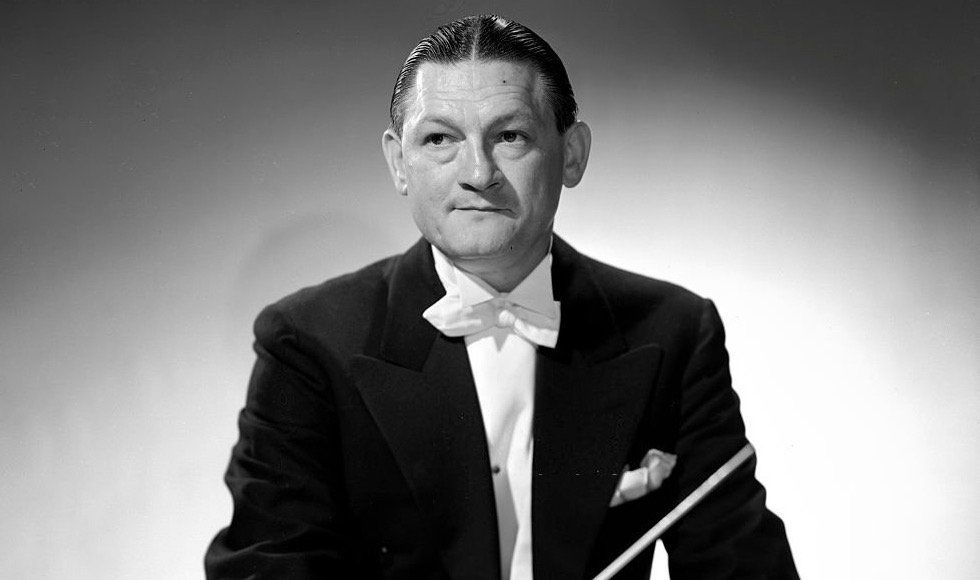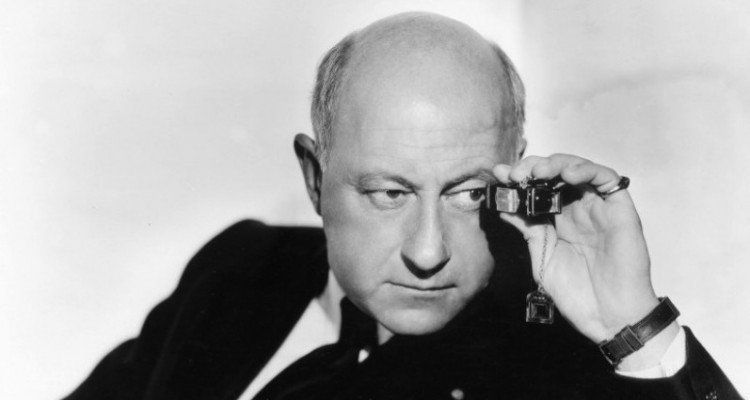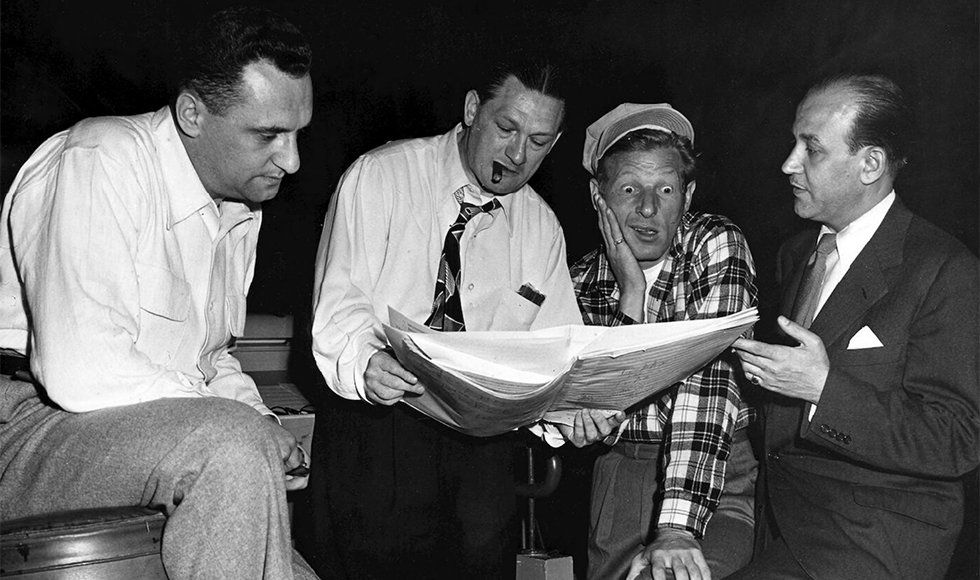Victor Young

Originally published in Soundtrack Magazine Vol.19 / No.76 / 2000
Text reproduced by kind permission of the editor, Luc Van de Ven and Dirk Wickenden
One of the most gifted composers and melodists in the Golden Age of Hollywood was Victor Young. He was born of Polish parents in Chicago on the 8th August 1900 and music was a part of the household, as his father William was an operatic singer. When he was six years old, young Victor started playing the violin, one of his ‘tricks’ being to play Yankee Doodle Dandy whilst holding the violin over his head. (At least he was not like Bernard Herrmann, who broke his violin over his teacher’s head!) Upon their mother’s death in 1910, Victor was sent to Warsaw with his sister Helen to live with their grandparents. His grandfather, recognising the boy’s musical gifts, made him polish the floor with cushioned feet whilst practising his scales and also enrolled him in Warsaw’s Imperial Conservatory, where one of his tutors was Roman Statlovsky, a protege of Tchaikovsky. Following his graduation, Young performed with the Warsaw Philharmonic. In 1917, during the First World War, he was arrested in Russia but escaped back to Warsaw, only to be arrested by the Germans upon his return.
Young and Willing - Young managed to return to the country of his birth three years later, although he found it hard to survive financially. Although he may have been bankrupt in the monetary sense, he was anything but musically bankrupt and the following year he performed for the first time at Chicago’s Orchestra Hall. Young was then offered $500 a week to tour on the vaudeville circuit; when he was told he would not be allowed to perform any classical music, he destroyed the contract. He got by with the occasional recital and then moved to Los Angeles, where his fiancé Rita had managed to secure him an audition with Sid Grauman. The man offered him the job of Concertmaster with the Million Dollar Theatre Orchestra. The following year, he became Concertmaster for Chicago’s Central Park Theatre, part of the Balaban and Katz group of movie theatres. Within a few years, he became the assistant musical director, arranging and composing music for silent movies. In 1928, he penned the first of his popular tunes, Sweet Sue (Just You) and, beginning his stint in radio in 1929, he then signed a major recording contract in 1931. As a performer, he played the violin solo on the first recording of Star Dust. His path to Hollywood was opened when Paramount Pictures offered him a contract in December 1935 and his tenure there would last the rest of his lifetime, a twenty year period encompassing what we know of as the Golden Age. Besides being Paramount’s chief composer, he also worked at Republic Studios, RKO, Columbia and 20th Century Fox.
Victor Victorious - Young’s overall musical personality was of the romantic style, influenced greatly by (as Miklos Rozsa described it) “Broadway-cum-Rachmaninoff” and, greatly assisted by his primary orchestrators Leo Shuken and Sidney Cutner, produced just the lush sound the studio heads were after.
The composer often took on too many films. In one year alone would work on a film at Columbia, a couple at Republic, in addition to the eight or nine he was contracted to score at Paramount. Paramount music editor Bill Stinson recalls that, due to his voluminous workload, the composer could be a bit sloppy with his cue timings, which would often be either too short or long for the scenes. The film would have to be edited to fit the music, but “the melody was so great that you overlooked it”. Young had a remarkable propensity for melody (the actual orchestral arrangements often left to his orchestrators) and many of his themes received lyrics by a number of talented songwriters, most famously Ned Washington for such songs as Around the World (1956’s AROUND THE WORLD IN 80 DAYS), Edward Heyman for ‘Love Letters’, the title tune of the 1945 film earning Young his first Academy Award nomination, and Sammy Cahn for ‘Written on the Wind’, a title tune from 1957 by Young, whilst the score was composed by Frank Skinner. Whilst some were featured in the movies, other successful melodies received lyrics after the fact and went on to become great hits. Perhaps one of Young’s best tunes was Stella by Starlight, from THE UNINVITED (1944, lyrics by Washington), which found its way into other films, including Jerry Lewis’ 1963 comedy THE NUTTY PROFESSOR (as Stella Stevens’ character Stella Purdy’s theme, though the score was by Walter Scharf).
It is perhaps startling to realise that a great many of the songs we think of as “standards” actually originated in Golden Age films, in fact many more than one might think. In the particular case of Victor Young, even today, one may happen upon his songs at any moment and they have become the favorites of jazz musicians the world over.
Words of Wisdom - Henry Mancini had great admiration for Young and is quoted as saying “Overall, Victor Young was my hero. I’ve gone down his path”. Young himself offered up this pearl of wisdom in a 1955 interview for the Chicago Sun-Times: “Writing a movie score is like a boy sitting in the balcony seat with a girl. He must be forceful enough to impress the girl- but not loud enough to attract the usher!.”
Another telling remark about the craft Young once made was “Why would any trained musician let himself in for a career that calls for the exactitude of an Einstein, the diplomacy of a Churchill and the patience of a martyr? Yet, after doing some 350 film scores, I can think of no other musical medium that offers as much challenge, excitement and demand for creativity in putting music to work.” In other words, a composer has to deal with those who think they know as much or more about music than the composer – the director, producer and everyone else!

Cecil B. DeMille had a long professional association with Victor Young, who had been working with DeMille since North West Mounted Police (1940).
De Director and De Composer - The director-composer relationship is often highlighted in the crafting of some of the better film music examples, to wit Spielberg & Williams, Schattner & Goldsmith, Cronenberg & Shore and so on. The great Hollywood equivalent of P. T. Barnum, Cecil B. DeMille established a working relationship with Young, whilst not as long and prosperous as some of the above pairings, spanning twelve years and six films, including 1940’s NORTH WEST MOUNTED POLICE, REAP THE WILD WIND two years later, SAMSON AND DELILAH (1949) and THE GREATEST SHOW ON EARTH from 1952 and was to culminate with THE TEN COMMANDMENTS (1956); however, Young, in his final year, was ill after working hard on a failed Broadway musical with lyricist Stella Unger, entitled SEVENTH HEAVEN, starring Gloria DeHaven, Ricardo Montalban and Chita Rivera. Young recommended politically suspect (in the Senator McCarthy sense) Elmer Bernstein to DeMille, who was already contracted to provide source music for a number of dances. Young did however supply an overture for the film and his long-time orchestrators Shuken and Cutner worked with Bernstein.
Shane’s Place in the Sun - A highly-regarded score in Young’s oeuvre is 1953’s SHANE, which he supplied a huge number of leitmotifs for. Despite this, director George Stevens asked Franz Waxman to rewrite some cues in the film. The opposite had happened on A PLACE IN THE SUN two years previously, when Stevens, although he loved Waxman’s saxophone theme for Elizabeth Taylor’s character, employed a number of composers contracted to Paramount to rewrite parts of the score. The lion’s share of the rescoring went to Daniele Amfitheatrof, who contributed around twenty five percent, whilst Victor Young contributed around ten percent, which consisted of the romantic scenes. So Waxman won his second Oscar for a score which was around sixty percent genuine Waxman.
Falling in Love - In 1952, Victor Young composed the score for the film ONE MINUTE TO ZERO, starring Robert Mitchum, Ann Blyth, William Talman and Richard Egan, directed by Tay Garrett and released by Howard Hughes’ RKO. The story concerns Mitchum’s Colonel Steve Janowski and his small troop in South Korea during the Korean War, trying to balance his job with the intrusion and then love interest of widow Linda Day (Blyth), a United Nations envoy. Although a somewhat minor film, it did give the composer another opportunity to write a winning love theme which has outlasted the film for forty-eight years – so far. With lyrics produced after the film, it has become known as ‘When I Fall In love (It Will Be Forever)’. The singer I personally associate the song with, due to my age, is Donny Osmond but it is most readily associated with Nat King Cole. The head of RKO’s music department from 1941-1955 was Constantin Bakaleinikoff, who received the music director credit on ONE MINUTE TO ZERO but unlike the same studio’s Roy Webb, who also worked as a music director, Bakaleinikoff served more as a conductor than a composer and arranger.
Beyond the love theme, the other major theme is a gung ho one for the American soldiers, a basic trumpet-led fanfare. As this is Korea, a couple of nominally exotic-sounding cues are spotted also. The first cue plays over the opening titles, white lettering against the United Nations logo, consisting of the military fanfare, which then gives way to a string-led rendition of ‘When I Fall in Love’, returning to the fanfare as the on-screen introduction is displayed. The love theme first appears as narrative music immediately following a rogue attack by an enemy plane, which Tanowski shields Day from. Despite their setting off on the wrong footing, placing the theme here may not have been dramatically correct from an intellectual viewpoint – they are not “in love” at this point but the theme perhaps underscores their initial attraction. Love of course does come later and when the two are either together or one is perhaps thinking of the other, the love theme is spotted, either just a fragment or a full blown rendition – Young is acting emotionally from a subliminal perspective, although it is designed to be manipulative to the audience. Another love theme appears for the other soldiers and their wives and this is rather attractive in a melancholy way but remains secondary to the “true” love theme of ‘When I Fall in Love’, which is reserved exclusively for Mitchum and Blyth.
One effective dramatic cue is scored when Janowski is left with little option but to order his men to fire upon a crowd of refugees, as there are also armed Korean soldiers hiding amongst them. The refugees, despite being ordered to halt, are driven on by the Korean soldiers and the music presents an aura of inevitability on low strings and woodwinds. The cue ends as the bombing starts and Mrs. Day looks on in horror. Young also indulges in a spot of mickey mousing here and there in the score. When an enemy tank is bazookered by Janowski, brass punctuates the impact and when the Koreans climb from the armoured vehicle, the composer uses a brief oriental scaling of the brass. More action specific scoring occurs when two of Janowski’s men garrotte four Korean soldiers.
A quasi-religious theme appears twice in the film, arranged for soft strings and woodwinds, with a pianissimo choir as Blyth prays in a bombed church and again appears as she asks God to keep the soldiers safe, including Janowski, as they set off for their next assignment, which is the very end of the film. Young ends this rendition against the RKO logo, in a hymnal-style coda with the orchestra stating the four-note “Amen”.
Overall, the film is a minor entry in the war genre and the melodrama is spiced with naturally occurring humorous moments, which are wisely not scored. The music is not of the more typical, opulent sound we might associate with Victor and the Golden Age. Whilst the term “golden” suggests a larger-than-life, grand scale film and score, it does of course refer to the huge productivity of Hollywood in the twenty-year or so period it encompasses.

Unknown man, Victor Young, Danny Kaye, and Dave Kapp look at a score during a recording session of
Tubby the Tuba for Decca Records
‘They Don’t Write ‘Em Like They Used To!’ - Whilst Young was not the only composer with a proclivity for a “tune”, it is not often these days that a song is crafted from a melody in a film score, unless it is included in the film in the first instance. It could be because they just don’t write good enough tunes these days, or that there aren’t that many talented lyricists around anymore. Bear in mind that, out of the three hundred and fifty films Young worked on in the capacity of composer, co-composer, songwriter or music director, a vast number of those he composed themes for had all the makings of a hit song.
In that respect, I believe his nearest equivalent today is James Horner. Like Young, Horner goes for a long line, attractive melody and uses that as his thematic base from which to launch the score itself. As has been the debatable practice for some years, a song or group of songs are just forced into a film, with little or no thought given to their dramatic usefulness. The rise of the powerful Music Supervisor in today’s industry is both a boon and a burden. Whilst there are talented supervisors, such as Sharon Boyle (MR. HOLLAND’S OPUS), many are just there representing a certain record label and to throw in as many songs from a catalogue as possible, giving the producers a marketable song compilation CD. For true songs to remember, look no further than the Victor Young back catalogue – they still knock the spots off even the most impressive of today’s ‘power ballads’.
In Memory of… Victor Young died on the 10th November 1956 in Palm Springs, California, a life cut short by a cerebral haemorrhage. Young had passed away during the scoring of CHINA GATE, the work on which was completed by his friend Max Steiner. In March of 1957, an Oscar was awarded posthumously for his score to AROUND THE WORLD IN 80 DAYS, the only Academy Award he won but one of twenty-two nominations (nineteen of those for scores and the remainder for songs). In 1960, a biographical film of Young’s life was planned by director Bernard Girard and producer Robert Lewis at Paramount, but the idea was soon nixed, which is a shame. Although the era of Victor Young’s style of scoring is very much past, the admiration of his music continues.
Ancestry notes on Victor Young by N. William Snedden. Ancestry records for Abe (aka Albert) Victor Young reveal the family’s Jewish name on his father’s side to be ‘Jablon’ (pronounced Yah boyn). He was the son of William D. Young, a tailor from Mlawa, Plock, Warszawa, Poland, who immigrated to America in 1889 and was later a tenor with the Joseph F. Sheehan Opera Company of Chicago. His mother was Rose Segal, also from Poland. Victor and his sister Helen (aka Anna/Annie) were cared for in Chicago by the Segal-Rosenbaum family following Rose’s death during child birth (1908). He began playing the violin at the age of six. Brother and sister were sent over to Poland to be educated under the care of their maternal grandparents. Circumstances forced the two siblings to remain in exile for a period of about ten years. Ellis Island records confirm both returned from Europe on the SS Nieuw Amsterdam, arriving New York City Feb. 11, 1920. According to an article published in the
Chicago Daily Tribune the following week, Victor was studying music at the time WW1 broke out, having enrolled at the Warsaw Imperial Conservatory where he studied violin with the virtuoso Izydor Lotto, as well as Roman Statlovksy (a pupil of Tchaikovsky), Barcesicz and Yarsembsky. He achieved the Diploma of Merit and embarked upon a career as a concert violinist making his debut with the Warsaw Philharmonic under Julius Wertheim before touring Europe. In 1917 he was interned by the Russians in Kiev following a recital and, after escaping with the help of a Bolshevik officer, subsequently captured by the Germans on his return to Warsaw by way of a cattle car. For a time he was under the protection of the American consul in Warsaw during the occupation of Poland.
Victor Young’s burial plaque in the Beth Olam Mausoleum, Los Angeles, gives his birth year as 1901 which is completely erroneous given his sister Helen was born Mar. 3, 1901, and was two years younger. The ASCAP Biographical Dictionary (Fourth Edition) has his year of birth as 1900. However, the Twelfth US census for West Town Chicago city, dated June 2 1900, lists ‘Abe V. Young’ born ‘Aug 1899 aged 9 months’, whilst his marriage certificate to Rita Kinel, dated LA Apr. 20, 1922, records his age as 23, consistent with the former year 1899.

Above: The Young family taken in Chicago ca 1906: Victor as a boy, father William, mother Rosa, and sister Helen. Photo right: Victor Young during his teens when he played concert violin for Nicholas II the last tsar of Russia. Images from
horwitzfam &
wroclaw courtesy of Bobbie (Roberta) Hill Fromberg whose mother was Victor’s sister Helen Young-Hill.



